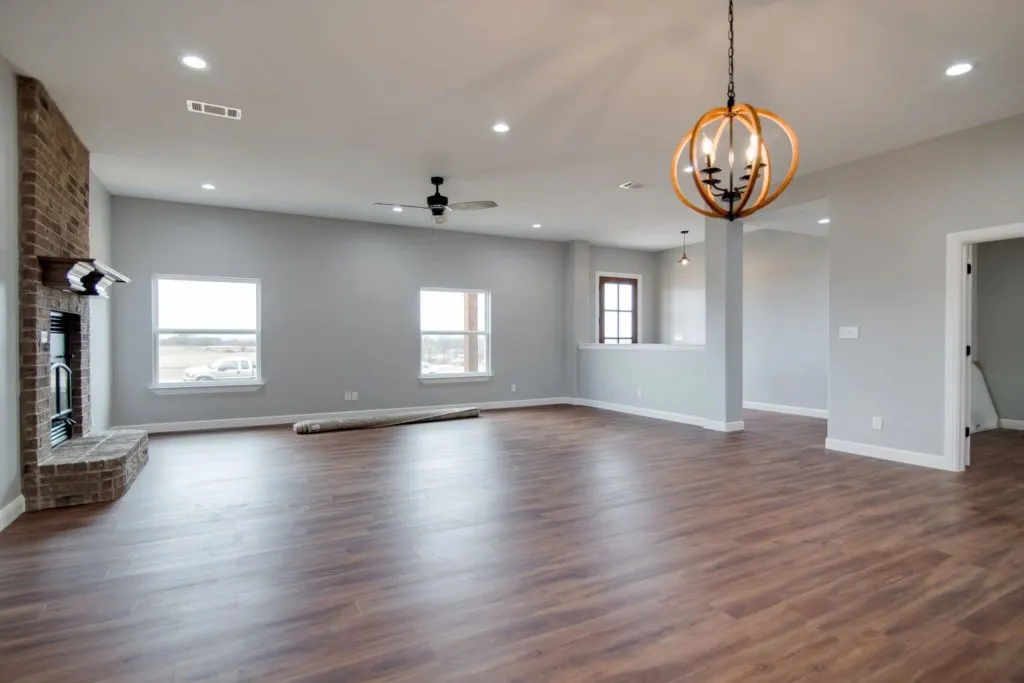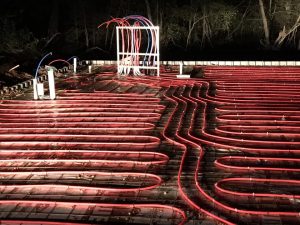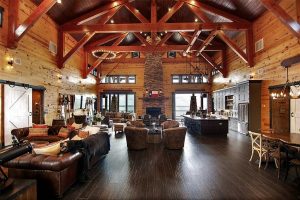
The cold sensation of bare feet on a concrete floor has caused many barndominium owners to rethink the idea of heating their entire square footage. Even before the first dirt is turned at groundbreaking.
Radiant Heat Flooring? Is it cost-effective? The cost is around $8.00 per square foot for electrically heated systems. Hydronic (water-based) systems cost about $6.00 per square foot. It is more efficient than baseboard heating and usually more efficient than forced-air heating because no energy is lost through ducts. This is according to the U.S. Department of Energy’s Energy Savers website.

Image courtesy EnergySage.com
Page Contents
Here are the three types of radiant floor heat:
- radiant air floors (heated air is the medium),
- electric radiant floors, and
- hot water (hydronic) radiant floors
Many barndominium owners are finding this to be a more cost-effective way of heating their barndos. Especially those with vaulted ceilings where available heat sometimes moves into the rafters and stays there.
The science behind the concept depends largely on something called “radiant heat transfer.” In other words, heat is delivered directly to a room’s occupants via the warm walls and floor — and even through the ceilings of some barn homes.
An everyday example of this concept would be if you placed your hands over a hot electric stove element. Same principle — only in this much larger scale case, the heating elements are concealed within the floor, walls or ceiling. And they may or may not be electric.
Radiant heat advantages
For one thing, such a heating system eliminates the need for baseboard heaters. (Those are considered by many to be the least efficient and most expensive heating option.)
And second, it eliminates the need for air ducts crammed into crawl spaces and attics, where significant heat loss can occur. Particularly when the fan forces the heat down a series of larger, then smaller ductwork. This often results in just a whisper of warm air by the time it reaches a person in a room far away from the heating source. In most cases, that is a furnace or heat pump, for example.
Third, folks with allergies swear by this form of heating, no matter what kind of dwelling has it. With radiant heating, there is nowhere for allergens to congregate and so bedevil an allergy sufferer.
In addition, the hydronic (liquid-based) systems use very little electricity — which can be very useful to a barndominium owner who chooses to build way off grid.
How is it heated, if not electrically?

This excellent image is provided courtesy of Kristin Nicole Mathis.
There are several options for heating the fluid before its trip down your concealed network of piping. Here they are with pros and cons in brief:
- gas or oil fired boilers
- wood-fired boilers
- solar water heaters or
- a combination of all three.
Oil-fired boilers produce more heat than other heating sources, but you must typically buy a storage tank and fairly expensive heating oil to run it.
Natural gas furnaces provide heat at a lower cost, but you must live in an area where it is readily available.
Wood-fired boilers require a ready supply of split wood and must be stoked continuously by hand in the cold winter months.
Solar hot water systems get sun-sourced energy and use it to heat water for your home. If your property is in the woods, this might not be an option for you.
Can radiant flooring heat a room?

It not only can heat a room, it can heat your entire barndo, including your shop area — more efficiently than conventional heating systems.
That’s the appeal of radiant floor heating, says This Old House plumbing and heating expert Richard Trethewey, who has long been a fan. “It’s truly invisible,” he says. But a radiant floor system has more than just aesthetics going for it. It’s also a highly efficient way to heat a house, increasing comfort as it reduces energy costs. (ThisOldHouse.com)
With radiant heat, warmth arises from the floor where hot water tubes or electric wires are buried just below the flooring surface. As the waves of thermal radiation rise, they warm up everything in the room — furniture, fixtures — and you.
“And even though the air temperature remains relatively constant, you stay comfortable because the surrounding surfaces aren’t stealing warmth from your body,” says ThisOldHouse.
How much is it per square foot?
Electric radiant floor heating costs about $5 to $7 per square foot for the materials or $8 to $12 or more per square foot with professional floor installation. Hydronic (water-based) systems cost about $6.00 per square foot.
What does that add up to? It can cost between $700 for a small bathroom to more than $10,000 for an entire 1500 sq ft house.
Which is the most cost-effective?
If you mean by cost-effective, when does an in-floor heating system pay for itself? You can take the above estimate for a 1500 sq ft home and divide the cost of installation by, say, $250 a month average baseboard heating costs. For a 1500 sq ft home at $7 a foot installed, the system would pay for itself in 42 months — or just over three years. If it costs more to install, or your heating bill runs more, just make the adjustment.
Having said that, there is a cost monthly to run your in-floor system. Compute your monthly propane or heating oil bill, and add it to the amortized payback schedule we devised above. If you have an electrical heating grid under your floors, take a percentage of your monthly electric bill and add that up.
If your system is hydronic, you’ll just pay for a bigger water heater or boiler up front — or maybe two of them, depending on how many zones you need to heat. Then payback or ROI would be figured using s combination of factors, including how much the system cost initially, what the estimated monthly cost will be to run it and any other secondary costs you can imagine.
When you arrive at your final figure, though, we’re willing to bet that it will be a happy number, vindicating your decision to make the investment.
Does radiant heat save money?
We believe that it does save money over time — again depending on the answers to the questions a little earlier. In fact, it’s a little hard for us to think of a scenario where you would be better off with a more conventional heating solution as a primary source of heat.
But beyond the money savings, there’s the added comfort factor.
Radiant floor heating heats a room from the floor up. That means that people will be more comfortable even if your thermostat is set lower than they are used to.
Usually, radiant heating systems bring the floor up to a comfortable temperature of 75 to 80 degrees F.
The floor surface — be it wood, tile or concrete — will radiate this heat up into a room instead of just randomly blowing it out. No more having to shiver unless you are in the direct flow of a vent.
Are there any energy tax savings available?
For those inclined toward a solar solution in 2019 — or those who completed installation of a solar-driven floor heating system in 2018 — very good news. The federal solar tax credit, also known as the investment tax credit (ITC), allows you to deduct 30 percent of the cost of installing a solar energy system from your federal taxes. The ITC applies to both residential and commercial systems, and there is no cap on its value. (SolarPowerRocks.com)
NOTE: We are not tax accountants. We pass these possibilities along in good faith that you will doublecheck the veracity of these claims. We’re not responsible if you don’t.
Can radiant heat be a primary heat source?
Here the debate rages on amongst barndominium owners who have installed radiant heat in their floor throughout and those heating by more conventional means. But the folks who have a radiant heat system in their floor are without exception very pleased with it.
“I wouldn’t go without it,” says a member of the Barndominium Life Facebook group.
Another FB member goes a step further: “Radiant floor heat is the most comfortable heat I’ve ever felt. Second would be a wood stove. Where I live, in Canada, we heat 8 months of the year.”
Is it available for DIY?
According to world renowned DIY retailer Home Depot, the answer to that question is a resounding “Yes!” And they will gladly sell you the supplies with which to do it.
“You can install radiant heat systems either above or below the subfloor. You can install the heating elements right against the floor. And, with a hydronic system, you can attach aluminum plates beneath the floor to spread and store heat.”
However, they caution that radiant heating works well with ceramic tile and vinyl, but not as well with wood floors.
Final thoughts
Is radiant heat right for your dream barndominium? Or your existing one? The systems’ proponents are adamant that once you’ve experience the warm, even heat put out by a subfloor heating system, you’ll never go back.
In fact, a third FB group member, who is currently building a huge barndo in central Missouri, has extended hot water piping even into his airplane hangar sized shop. The bay measures 60 feet by 80 feet. His living quarters are also comfortably large, at 24 by 80 feet. All that square footage will be heated.
He won’t be using his floor as his only source of heat, though. “I’ll also use propane,” he says.
In conclusion
For most every barndo owner who is still in the planning process, it might be a good idea to research the possibilities of radiant floor heating for yourselves. Check with your builder, if you are going turnkey.
And if you’re taking the owner-builder route, make sure you have a system that will fit your individual energy goals and needs.
If you already have installed one of thee systems in your barndominium, please tell us about it in the Comments section below.



